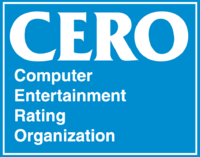Computer Entertainment Rating Organization facts for kids
 |
|
| Nonprofit organization | |
| Industry | Video game content rating system |
| Founded | June 2002 |
| Headquarters | Chiyoda, Tokyo, Japan |
|
Area served
|
Japan |
|
Key people
|
Kazuya Watanabe |
Have you ever seen a letter on a video game box and wondered what it meant? In Japan, an organization called the Computer Entertainment Rating Organization, or CERO for short, puts those ratings on games. CERO is a group based in Tokyo that checks video games for consoles. Their job is to give each game a rating.
This rating helps players and their parents understand what kind of content is in the game. It tells you what age group the game is best for. CERO was started in 2002 to help everyone make smart choices about the games they play.
What Do the CERO Ratings Mean?
CERO updated its rating system in 2006 to make it easy to understand. The symbols are letters, like grades you might see in school. Each rating tells you if a game is right for your age. You can find the rating symbol on the bottom-left corner of the front of the game box. The spine of the box also has a colored bar that matches the rating.
What Are the Content Icons?
On the back of the game box, you might see small pictures called "content icons." These icons tell you why a game got a certain age rating. They show what kind of specific content is in the game. Games rated "A" for All Ages do not have these icons.
Here is what some of the icons mean:
How Are Games Rated?
So, how does a game get its rating? CERO has a special team of reviewers. These people are not connected to any video game companies, so they can give a fair opinion.
First, the team is trained by rating older games to learn the system. Then, when a new game comes out, they play it and look for different kinds of content. They use a list of expressions and themes to see where the game fits in the rating scale.
There are very strict rules about what is allowed. Some content is considered "banned," meaning it is not allowed in games sold in stores. The reviewers check for everything, from fighting and scary scenes to the kind of language used.
After the team reviews the game, they send their notes to the main CERO office. The office then looks at all the reviews and decides on the final rating that you see on the box.
See also
 In Spanish: Computer Entertainment Rating Organization para niños
In Spanish: Computer Entertainment Rating Organization para niños









